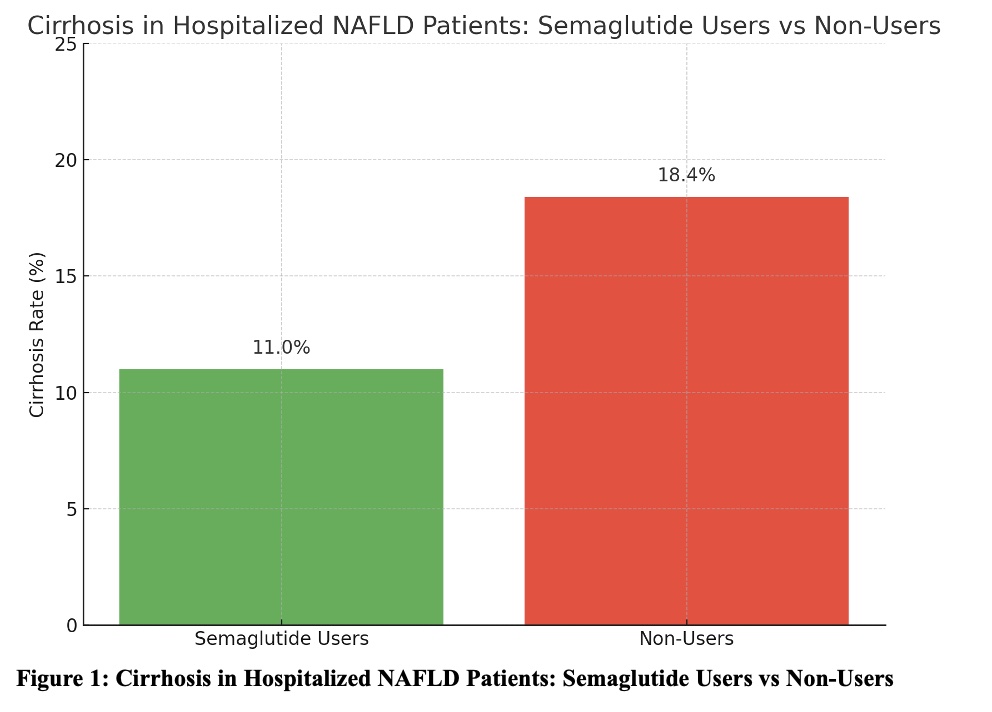Monday Poster Session
Category: Liver
P3683 - Semaglutide Use Is Associated With Lower Risk of Cirrhosis Among Hospitalized Patients With Non-Alcoholic Fatty Liver Disease: A Nationwide Analysis Using the National Inpatient Sample
Monday, October 27, 2025
10:30 AM - 4:00 PM PDT
Location: Exhibit Hall

Ashish Sharma, MD (he/him/his)
University of Connecticut-Hartford
Rocky Hill, CT
Presenting Author(s)
Harendra Kumar, MBBS1, Angad Tiwari, MBBS2, Ashish Sharma, MD3, Amanda Frondella, MD4, Mohit Kale, MD5
1Dow University of Health Sciences, Karachi, Sindh, Pakistan; 2Maharani Laxmi Bai Medical College, Ghaziabad, Uttar Pradesh, India; 3University of Connecticut-Hartford, Hartford, CT; 4University of Connecticut Health, Farmington, CT; 5Landmark Medical Center, Woonsocket, RI
Introduction: Non-alcoholic fatty liver disease (NAFLD) is a serious public health concern and the main cause of chronic liver disease worldwide. The development of cirrhosis greatly increases morbidity, mortality, and healthcare expenditures. Semaglutide, a GLP-1 receptor agonist used to treat type 2 diabetes and obesity, has shown hepatoprotective properties in preclinical investigations. However, its real-world influence on cirrhosis-related outcomes has not been adequately studied.
Methods: We conducted a cross-sectional study using the National Inpatient Sample (NIS) from 2016 to 2020. We included adult patients (≥18 years) with NAFLD (ICD-10: K76.0). Semaglutide exposure was measured in patients with type 2 diabetes (E11.x) using the long-term drug usage code (Z79.899), which reflects real-world prescription patterns. The most significant finding was cirrhosis (ICD-10: K74.x) discovered during the same hospitalization. Multivariable logistic regression was used to calculate adjusted odds ratios (aOR) for cirrhosis while controlling for age, gender, race, obesity, diabetes duration, hypertension, dyslipidemia, and hospital-level variables.
Results: Among 68,250 (7.0%) of 975,000 hospitalized persons with NAFLD was found that they had been exposed to semaglutide. Cirrhosis was detected in 18.4% of non-users compared to 11.0% of semaglutide users (p< 0.001). After normalization, semaglutide intake was associated with a significantly decreased risk of cirrhosis (aOR: 0.54; 95% CI: 0.47-0.62; p< 0.001). This protective connection was consistent across subgroups, including those with obesity, long-term diabetes, and Hispanic ethnicity. Hospitalization costs and lengths of stay were similar across the two groups.
Discussion: In this large, nationally representative inpatient cohort, semaglutide treatment was independently associated with a 46% decrease in the incidence of cirrhosis among NAFLD patients. These results provide real-world evidence of the potential hepatoprotective impact of GLP-1 receptor agonists and metabolic-targeted medicines in controlling liver disease development.

Figure: Figure 1: Cirrhosis in Hospitalized NAFLD Patients: Semaglutide Users vs Non-Users
Disclosures:
Harendra Kumar indicated no relevant financial relationships.
Angad Tiwari indicated no relevant financial relationships.
Ashish Sharma indicated no relevant financial relationships.
Amanda Frondella indicated no relevant financial relationships.
Mohit Kale indicated no relevant financial relationships.
Harendra Kumar, MBBS1, Angad Tiwari, MBBS2, Ashish Sharma, MD3, Amanda Frondella, MD4, Mohit Kale, MD5. P3683 - Semaglutide Use Is Associated With Lower Risk of Cirrhosis Among Hospitalized Patients With Non-Alcoholic Fatty Liver Disease: A Nationwide Analysis Using the National Inpatient Sample, ACG 2025 Annual Scientific Meeting Abstracts. Phoenix, AZ: American College of Gastroenterology.
1Dow University of Health Sciences, Karachi, Sindh, Pakistan; 2Maharani Laxmi Bai Medical College, Ghaziabad, Uttar Pradesh, India; 3University of Connecticut-Hartford, Hartford, CT; 4University of Connecticut Health, Farmington, CT; 5Landmark Medical Center, Woonsocket, RI
Introduction: Non-alcoholic fatty liver disease (NAFLD) is a serious public health concern and the main cause of chronic liver disease worldwide. The development of cirrhosis greatly increases morbidity, mortality, and healthcare expenditures. Semaglutide, a GLP-1 receptor agonist used to treat type 2 diabetes and obesity, has shown hepatoprotective properties in preclinical investigations. However, its real-world influence on cirrhosis-related outcomes has not been adequately studied.
Methods: We conducted a cross-sectional study using the National Inpatient Sample (NIS) from 2016 to 2020. We included adult patients (≥18 years) with NAFLD (ICD-10: K76.0). Semaglutide exposure was measured in patients with type 2 diabetes (E11.x) using the long-term drug usage code (Z79.899), which reflects real-world prescription patterns. The most significant finding was cirrhosis (ICD-10: K74.x) discovered during the same hospitalization. Multivariable logistic regression was used to calculate adjusted odds ratios (aOR) for cirrhosis while controlling for age, gender, race, obesity, diabetes duration, hypertension, dyslipidemia, and hospital-level variables.
Results: Among 68,250 (7.0%) of 975,000 hospitalized persons with NAFLD was found that they had been exposed to semaglutide. Cirrhosis was detected in 18.4% of non-users compared to 11.0% of semaglutide users (p< 0.001). After normalization, semaglutide intake was associated with a significantly decreased risk of cirrhosis (aOR: 0.54; 95% CI: 0.47-0.62; p< 0.001). This protective connection was consistent across subgroups, including those with obesity, long-term diabetes, and Hispanic ethnicity. Hospitalization costs and lengths of stay were similar across the two groups.
Discussion: In this large, nationally representative inpatient cohort, semaglutide treatment was independently associated with a 46% decrease in the incidence of cirrhosis among NAFLD patients. These results provide real-world evidence of the potential hepatoprotective impact of GLP-1 receptor agonists and metabolic-targeted medicines in controlling liver disease development.

Figure: Figure 1: Cirrhosis in Hospitalized NAFLD Patients: Semaglutide Users vs Non-Users
Disclosures:
Harendra Kumar indicated no relevant financial relationships.
Angad Tiwari indicated no relevant financial relationships.
Ashish Sharma indicated no relevant financial relationships.
Amanda Frondella indicated no relevant financial relationships.
Mohit Kale indicated no relevant financial relationships.
Harendra Kumar, MBBS1, Angad Tiwari, MBBS2, Ashish Sharma, MD3, Amanda Frondella, MD4, Mohit Kale, MD5. P3683 - Semaglutide Use Is Associated With Lower Risk of Cirrhosis Among Hospitalized Patients With Non-Alcoholic Fatty Liver Disease: A Nationwide Analysis Using the National Inpatient Sample, ACG 2025 Annual Scientific Meeting Abstracts. Phoenix, AZ: American College of Gastroenterology.
